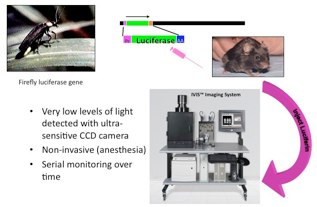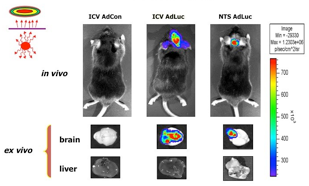In Vivo Bioluminescence Imaging
- Similar to other long-lasting neuronal processes such as plasticity, regeneration and apoptosis, it is likely that sustained alterations in central cardiovascular networks require changes in gene expression.
- A major mechanism by which transient receptor/ligand signals such as Ang-II/AT1 and ROS are transformed into long-term genetic changes is through the activation of transcription factors (TF) such as nuclear factor kappa B (NFkB) and activator protein-1 (AP-1).
- Longitudinal tracking of NFkB and AP-1 activation in vivo is carried out by viral gene transfer of NFkB- or AP-1-dependent luciferase reporters to specific cardiovascular tissues (e.g., specific CNS circuits, left ventricle of heart, etc.). In vivo bioluminescence imaging is performed using an IVIS (Xenogen) instrument.




